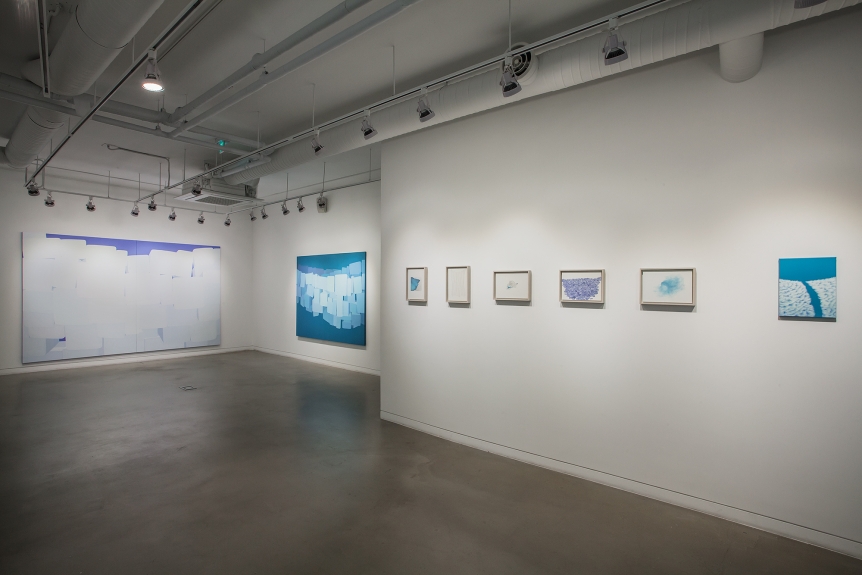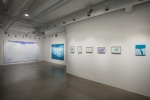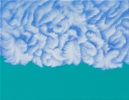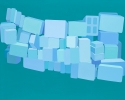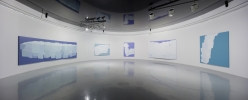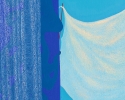White Silence 전시서문 / 2018.3.7 ~ 3.19 / 갤러리밈
<보이지 않는 벽에 관하여>
최정윤 (독립 큐레이터)
흰색 고요(silence), 푸른색 차가움…. 평면을 바라보는 경험에서 우리는 단순히 보는 것 이상의 경험을 하게 될 때가 있다. 시각적 경험을 토대로 청각적 혹은 촉각적 분위기를 상상할 수 있으며, 더 나아가 심리적인 경험까지 이어진다. 한 점의 그림으로 우리는 셀 수 없이 많은 갈래의 가지를 치며 생각을 이어나간다.
어떤 회화 작품을 보면 특정 작가가 바로 연상되는 경우가 있다. 어떤 대상을 반복적으로 그리는 경우, 혹은 붓 터치나 색감이 독특하게 일관된 경우가 이에 해당된다. 하지만 정반대로 자신이 쌓아 온 기존 작업 스타일의 제약에서 벗어나 과감하게 새로운 시도를 지속하는 작가도 있다. 정유미 작가는 후자에 더 가깝다. 그는 2008년부터 현재까지 사람과 사람 혹은 다른 대상 사이의 관계, 안과 밖의 경계와 그 차이, 기억을 좇아 재구성한 시공에 관해 지속적으로 다루어 왔다. 하지만 시기에 따라 그것을 표현하는 방식이나 사용한 재료, 기법의 측면에서 끊임없이 변화해 왔다. 시간이 지나고 상황이 바뀌면서 사람도 변하듯이, 물 흐르듯 자연스럽게 작품에도 영향을 끼쳤다. 이번 전시에는 'The Wall in the mind'(2016-2017) 시리즈와 2016년부터 현재까지 진행하고 있는 드로잉 작업 중 일부를 소개한다.
'The Wall in the mind' 시리즈 작업을 먼저 살펴보자. 흰색을 한껏 머금은 푸른빛 컬러 위에 다양한 크기의 직육면체들이 쌓여 있다. 단색으로 평평하게 처리한 배경은 대상을 둘러싼 모든 상황과 맥락을 지워낸 것으로 보이고, 대상 역시 무엇이라고 단언하기 어려운 형태를 가진다. 'The Wall in the mind Ⅳ'에서는 직육면체의 오브제가 켜켜이 쌓여 있는데, 색과 형태에서 유추하건대 얼음 같기도, 각설탕 같기도 하다. 온도가 조금만 따뜻해지거나, 뜨거운 물을 붓는 순간 사라 없어질 것만 같이 연약하게 느껴진다. 또 반대로 'The Wall in the mind Ⅴ'에서는 화면 가득 직육면체 덩어리들이 시야를 가로막고 있어 흰색 벽돌처럼 견고하게 보이기도 한다. 연약함과 견고함, 두 가지의 특성을 모두 갖춘 대상, 넌센스 퀴즈처럼 들릴 지라도 그게 무엇일지 고민해보게 만든다. 작가에 따르면, 시리즈의 제목 ‘The Wall in the mind’처럼, 이 작품들은 “타인과의 관계 속에 존재하는 심리적 경계 혹은 심리적인 막과 맞닿아 있다.” 눈에는 보이지 않는 어떤 것을 평면 위에 시각화하기 위해서 작가가 거쳤을 고민의 흔적들이 화면 안에 고스란히 담겨 있는 셈이다.
전시에 출품된 캔버스 작업은 모두 아크릴 물감을 재료로 사용했다. 물감의 두께감이 거의 느껴지지 않을 정도로, 붓 자국을 찾기 어려울 정도로 평평하게 채색되었으며, 빈 공간 없이 매트하게 물감이 발라졌다. 대상은 명암법을 최소한으로 사용해 그려졌는데, 직육면체들 사이에 하나의 단위를 이루는 형태들이 한 덩어리로 엮이지 않고 개별적으로 보일 수 있도록 측면이나 바닥면 위주로 짙은 색으로 처리했다. 다시 말해, 정유미가 화면 안에 담은 대상은 지극히 현실적인 대상 같지만, 동시에 절대로 현실에는 존재할 수 없는 방식으로 화면 안을 부유하고 있는 것이다. 지금까지 살펴본 색, 형태, 표현 방식보다도 이 시리즈의 특성을 가장 잘 표현해주고 있는 부분은 다름 아닌 작품의 크기다. 'The Wall in the mind' 시리즈의 작품은 작게는 150x190cm부터 가장 큰 작품은 200x300cm로, 관객의 평균키가 170cm 정도라고 가정할 때, 관객의 눈높이에 맞추어 작품을 건다 하더라도 관객은 작품이 걸린 가장 높은 지점보다는 아래에 서 있게 된다. 전시장에 걸린 이 작품 앞에 서는 모든 관객은 모니터에서 이미지로 혹은, 전시 소식을 담은 엽서의 크기로 이 작품을 볼 때와는 완전하게 다른 경험을 하게 되는 것이다. 작품 안에서 견고히 세워진 흰 벽은 우리의 시야를 가리며 안과 밖을 나누는 역할을 한다. 어쩌면 그에게 있어 ‘보이지 않는 벽’은 자기 스스로 쌓아놓은, 언젠가는 허물어질 수 있는, 그런 자신 안의 벽일지도 모르겠다.
전시장에서 마주할 수 있는 또 다른 작품으로는 몇 점의 드로잉이 있다. 정유미는 런던(2012~2014)에서 유학 생활을 하고, 아이슬란드(2015)와 노르웨이(2016)에서 레지던시 프로그램에 참여하여 3개월여씩 체류하면서 언어와 문화가 다른 익숙하지 않은 상황에 스스로를 위치시켰다. 그 안에서 차근차근 자신이 보고 듣고 느낀 감정과 생각들을 마치 일기를 쓰듯 드로잉으로 남겨 모아두었다. 현지에서 구할 수 있는 재료로, 변화된 환경에 반응하는 자신을 오롯이 느껴보는 경험 말이다. 이후에도 현재까지 드로잉하기를 멈추지 않고 지속하고 있다. 우리가 그의 드로잉에서 마주하게 되는 것은 선과 색, 그리고 명확히 식별하기 어려운 형태로 치환된 행위의 집적이다. 커다란 흰 캔버스 앞에서 선 페인터는 모두 같은 고민에 직면할 것이다. 무엇을, 어떻게 그릴 것인가의 질문 말이다. 정유미와의 대화 가운데 기억에 남는 말이 있다. 그는 무엇인가를 결코 보고 그리지 않으며, 어떤 것을 재현하는 데에는 관심이 없다고 말했다. 머리로 완성된 대상을 쫓지 않는 대신, 그는 붓과 연필의 움직임에 몸을 맡긴다. 드로잉에서 볼 수 있는 이러한 자유로움에서 새로운 가능성을 엿본다. 이는 끊임없이 고민하기를 멈추지 않은 정유미의 다음 작업을 기대하게 한다.
Yumi Chung solo exhibition 'White Silence' / 2018.3.7 ~ 3.19 / Gallery MEME (Seoul)
About the Invisible Wall
Jeongyoon Choi (Independent curator)
White silence, blue coldness. An experience waits in a flat surface beyond the boundary. The atmospheric touches and sounds through visual stimulation are the path for the psychological experience. Our thoughts depart from a single painting to travel through the branching complexity of ideas.
Certain paintings belong in association with certain artists commonly through repeating themes of an object or the unique technique of the brush or colour. On the contrary the artist may continually challenge the determining patterns of their work offering new ways to communicate their work. Yumi Chung belongs to latter. Since 2008 onward, Chung’s relationship between beings or other objects are her constant - the boundaries between the inside and outside and the reconstructed space and time born of past memories. Yet, the methods and materials expressed through Chung’s artwork are rebirthed. Chung’s art works, like people and their environment are related but impermanent. This exhibition displays Yumi Chung’s recent series of work 'The Wall in the mind'(2016-2017) and part of Chung’s new drawings produced since 2016.
First, let us look into the series of 'The Wall in the mind'. Various sizes of rectangular shapes are piled on top of each other on the blue coloured background filled with white ambience. The single coloured flat background seems to remove the stories and circumstance that orbit the object and thus the definition of the object itself remains unclear. The rectangular objects piled in 'The Wall in the mind Ⅳ' are reminiscent of an ice or sugar cube in their particular colour and shapes. Vulnerable to the elements as if likely to disappear in rising temperature or if hit by a drop of hot water. In opposition, the rectangular object filled in the 'The Wall in the mind Ⅴ' recalls the solid white bricks for they firmly block the wide view of canvas from the audience. This ironical object that is both fragile and robust invites ones striving curiosity. As for the title ‘The Wall in the mind’ suggests, Chung explains as it “touches the psychological boundaries or layer within our relationship with others.” The canvas then becomes the artistic trace of Chung’s creative journey through the process of visualization of something invisible.
Chung chose acrylic paint as the main material used for each of her paintings in this exhibition. The canvases painted so evenly that each bush stroke is hardly noticeable. The object is expressed within the minimal contrast, a simplified shade to the side or bottom that separates the individual shapes from the collective lumps. Here where objects exist within the canvas they may seem to have physical spatial quality, yet float on the screen in the surreal way. The significance of these paintings over its colour, shape and the expression is the actual scale of the art. The size of painting in the series of 'The Wall in the mind' starts from 150x190cm to that of maximum 200x300cm. If we presume the average high of audience around 170cm, the artwork hung on the eyelevel of audience’s perspective will be positioned above the high of audience in its highest point. This large scale of Chung’s paintings present the audience who stands in front of her artwork, the completely different experience from the digital images captured in the screen or brochure. The firmly stood white wall divides the boundaries between inside and outside as it blocks the view from the audience. Perhaps this ‘invisible wall’ is Chung’s inner barrier built up by herself, which may collapse one day.
There are also few drawings Yumi Chung introduces in this exhibition. While Chung studied MFA in London (2012-2014) and participated in the residency programs in Iceland (2015) and Norway (2016), she actively setts herself into the unfamiliar alien environments where she visually documented the changes of her emotions, ideas and feelings from the external stimuli provided. Through the medium of drawing, Chung records her solitary inner experience as it occurs in the different surroundings by using local materials. What we witness on Chung’s drawings are the performing transformation through lines, colours and that of indefinable shapes. Every artist facing the empty canvas bears the same fundamental agony of what and how to paint. During the conversation with the artist, Yumi Chung mentioned that she is never interested in coping or reproducing the image of an object onto canvas. Chung refused to chase the image predetermined. Instead, she lets the brushes and pencils to perform with her. This creativity emerges in her drawings and paintings, together with Chung’s ceaseless dedication we can anticipate the fresh potential of her future work.
